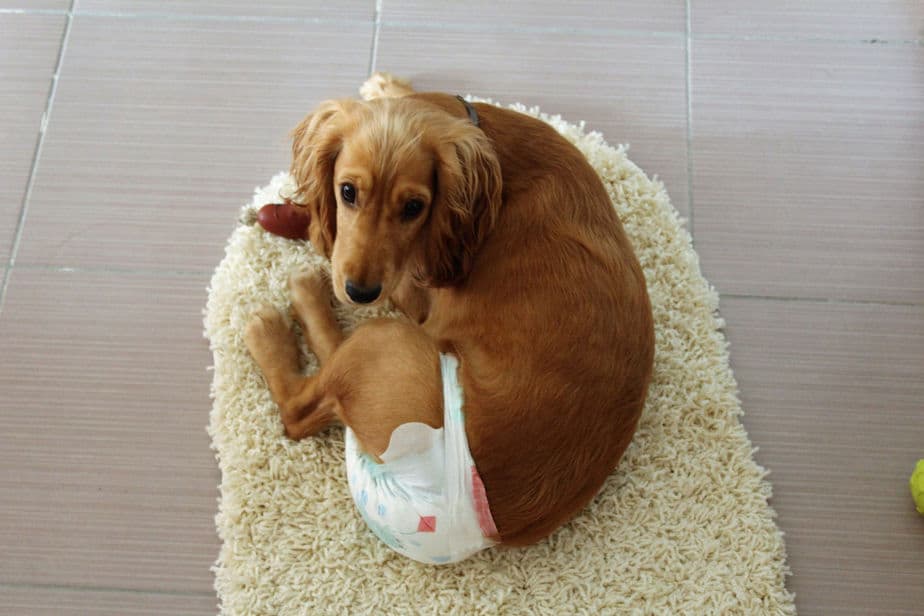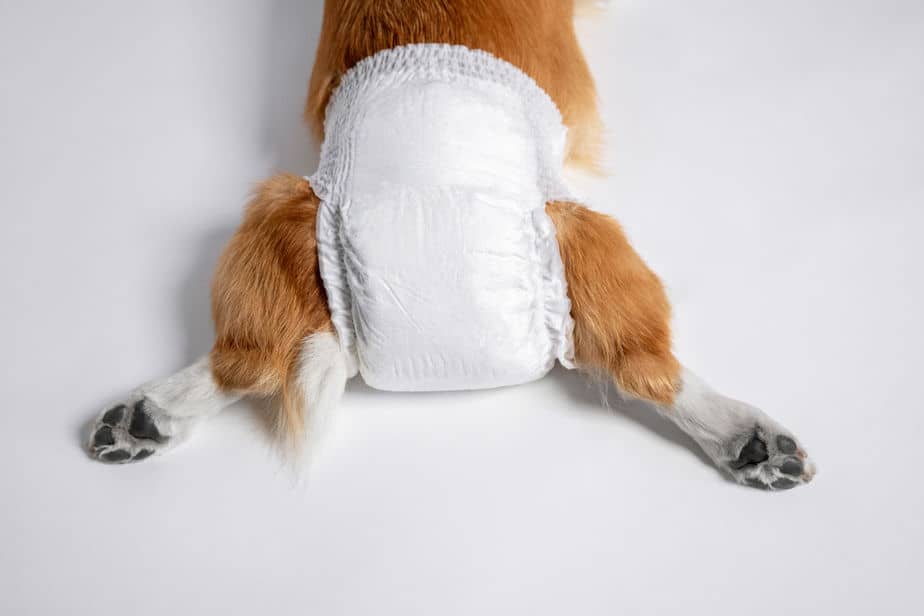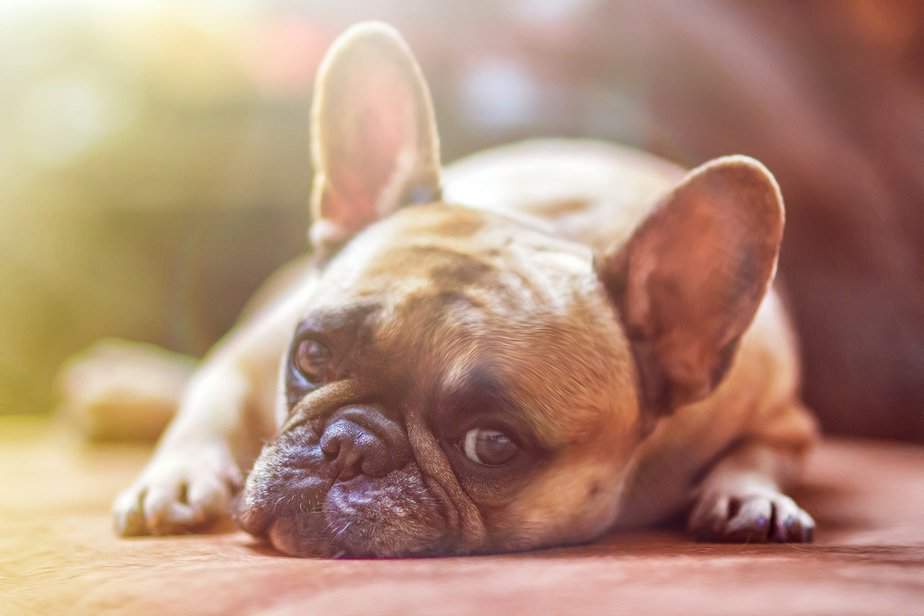By Dr. Sara Ochoa – Practicing Veterinarian
If you have a female dog, they may have just started going into heat and having a “period”. Technically dogs don’t have periods as they don’t shed their uterus lining the same way as humans. But it does look like that’s what’s happening and in this post we give you the ins and outs of dogs going into heat.
At first, you may think there is something wrong with your dog after noticing bloody discharge from their vulva. Most of the time, this is normal and will go away after a few days to a week.
Do dogs have periods?
Female dogs have an estrus cycle, and is referred to as going into heat, rather than the term “period“. If they are spayed then they won’t have this cycle.
Dog heat cycles are different from human periods. Whilst humans shed their uterus lining, dogs absorb it if they have not been impregnated. This is called a heat cycle.
Like humans, dog heat cycles are affected by hormones produced by the ovaries. These hormones are responsible for getting the uterus ready for pregnancy. This process requires the uterus to be supplied with extra blood in preparation for breeding.
This causes the blood that you see during their heat cycle.
In women, bloody discharge signifies the end of a reproductive cycle, whereas in dogs, bloody discharge indicates the dog is fertile and ready to breed.
When do dog heat cycles start?
Your female dog will first have their first heat cycle when she is about 6 months of age. Many times, their first cycle may be missed since it is a very small amount of bleeding, and most dogs like to be very clean and will constantly lick themselves to keep themselves clean.
Smaller dogs may have their first heat cycle earlier in life, 5-6 months in some cases, whereas large breed dogs may start having their first heat cycle around 8 months of age, and even up to 1-2 years.
If you’re wondering what to do when you dog has heat cycle, then be sure to read our post about that subject.

How long do dog heat cycles last?
Most dog heat cycles will last about 7 to 10 days. This would be when you visibly see them bleeding. Their whole heat cycle will last 2 to 4 weeks where they are undergoing hormonal changes and are accepting a male to mate.
What does a typical heat cycle in a dog look like?
Your dog will first start their cycle with their vulva starting to swell. After this, you will notice a little bit of bloody discharge from their vulva. Many times this starts a few days after they first start their cycle.
Your dog may have heavy bleeding at first, and it will start to slow down as their cycle comes to an end.
During their heat cycle, you may notice that your dog is urinating a little more often.
This is how they release hormones and pheromones to signal to a male dog that they are in heat and ready to be bred.
Most female dogs will start allowing male dogs to breed them around 7 to 10 days into their cycle.
Your dog will be done with their heat cycle when you no longer see any blood and their vulva is no longer swollen.
If your dog is bleeding too much, or their swollen vulva is larger than what is considered normal during their heat cycle, then be sure to read our post Dog in Heat: Problems and Help.

How often do dogs get their heat cycle?
Most dogs will have a heat cycle every 6 months. They can be as long as 8 to 10 months and as short as 3 months between heat cycles. Most dogs will be very consistent on their time between each cycle.
You might also like to read our post, Is My Dog Pregnant or Fat? Here’s How to Tell
How does my vet tell if my dog is in heat?
There are two different tests that your vet can run to see if your dog is in heat and ready to mate.
- Vaginal cytology:
Your vet can take a swab of your dog’s vulva with a cotton tip applicator. They can smear this swab on a glass slide and look at it under the microscope.
During your dog’s heat cycle, the cells that line the vulva will change in appearance. Your vet will easily be able to tell you if your dog is in heat and ready to be bred.
- Blood testing:
A progesterone test can also be used to determine if your dog is in heat. This test may be able to be performed at your vet clinic, or it may have to be sent off the lab for the most accurate results.
If you are trying to breed your dog, your vet can work with you on determining the most accurate time to breed your dog.
Do dogs get period cramps?
No, it is unlikely that dogs get “period cramps” during their heat cycle. Dogs do not shed their uterus lining as humans do, however, absorb their lining back into their body. It’s possible that there is discomfort associated with this process, however, it’s more probably discomfort comes from hormonal changes.
The process of reabsorbing their uterus lining is referred to as covert menstruation. Allowing your dog to rest and not go on any long walks will help them to be more comfortable during this time.
Do spayed dogs have heat cycles?
If your dog is spayed, they should not have a heat cycle. There is one instance where they will have a cycle. If your dog has any ovary tissue left from their spay, they can still have a heat cycle, but they cannot get pregnant during this time.
Ovarian remanent syndrome is when a piece of the ovary was left during your dog’s spay, causing them to still have signs that they are in heat.
If your dog is still having a heat cycle after they have been spayed, it would be best for your vet to run bloodwork to see if they have an ovarian remanent syndrome or something else is causing them to bleed.
If your dog does have an ovarian remanent syndrome, this can easily be corrected by surgically removing the rest of the ovarian tissue.
Your dog would need to have this procedure done when they are in heat so that it is easier to find the ovarian tissue.

Do dogs have heat cycles every month?
No, dogs do not have a heat cycle every month. They only have their cycles a few times each year. Small dogs tend to go into heat every 3 to 4 months. Other dogs, it can take up to 18 to 24 months for them to have their next cycle.
Do dog heat cycles get shorter with age?
As your dog gets older, their cycles will become shorter and less frequent. Your dog will eventually go through menopause and stop having heat cycles.
This usually occurs around 10 to 12 years of age. Some dogs will have heat cycles their whole life, and some dogs may only have one or two during their lifetime.
If you notice anything different with your dog’s heat cycle or it seems like they are happening very often, it’s best that your vet checks your dog to make sure that there is nothing wrong.
Do dog heat cycles smell?
Your dog’s heat cycle may cause a little odor, but they should not be very smelly. If your dog is having blood discharge from their vulva that is very smelly, it would be best to see your vet. This could be a sign of a pyometra.
A pyometra is an infection in your dog’s uterus. This usually occurs shortly after your dog is in heat.
The hormonal and physical changes that happen when your dog is in heat can cause your dog’s uterus to get infected. This uterus can fill with pus causing your dog to have a creamy, bloody discharge.
If your dog does have a pyometra, your vet will want to do emergency surgery to remove the uterus and the infection.
If left untreated, this infection can cause the uterus to rupture, allowing the pus to enter your dog’s abdomen and bloodstream. Your dog could then become septic and die.
When would I need to see my vet?
Many times, if your dog is having a heat cycle, you will not need to see your vet. If you notice anything abnormal with their heat cycle, it may be time to see your vet.
Some dogs may have a urinary tract infection and are urinating blood, but it looks like they are in heat.
If you notice that your dog is producing a very large amount of blood, it is always best for your vet to check them out just to make sure that there is nothing else wrong.
Final Thoughts
If your dog is not spayed, you can expect them to come into heat about every 6 months starting when they are 6 to 8 months old.
Many people do not want to have to deal with the bleeding, clean up and mess that can be associated with a heat cycle. This is one reason that many people spay their dogs.
A spayed dog will not have a heat cycle as these cycles are caused by hormones released by the ovaries.
If your dog is bleeding from the vulva and they are spayed, or they should not be having their heat cycle, it is best to see your vet.
There are a few medical issues that can cause your dog to seem like they have a heat cycle that may be life-threatening if left untreated.
Heat cycles can be a challenge to deal with at first but learning everything that you can about your dog’s heat cycle will help you to recognize any changes in your dog and when you should seek the advice of your veterinarian.




